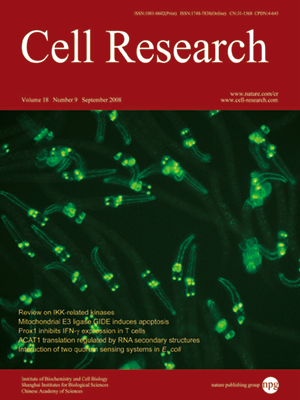
Volume 18, No 9, Sep 2008
ISSN: 1001-0602
EISSN: 1748-7838 2018
impact factor 17.848*
(Clarivate Analytics, 2019)
Volume 18 Issue 9, September 2008: 900-910
ORIGINAL ARTICLES
GIDE is a mitochondrial E3 ubiquitin ligase that induces apoptosis and slows growth
Bicheng Zhang1,*, Jun Huang2,*, Hong-Liang Li3,*, Ting Liu2, Yan-Yi Wang4, Paul Waterman1, Ai-Ping Mao4, Liang-Guo Xu1, Zhonghe Zhai2, Depei Liu3,?, Philippa Marrack1,? and Hong-Bing Shu4,?
1HHMI, National Jewish Medical and Research Center, Denver, CO 80206, USA
2College of Life Sciences, Peking University, Beijing 100871, China
3Institute of Basic Medical Sciences, Chinese Academy of Medical Sciences, Beijing 100005, China
4College of Life Sciences, Wuhan University, Wuhan 430072, China
Correspondence: Hong-Bing Shu(shuh@whu.edu.cn )
Here, we report the identification of GIDE, a mitochondrially located E3 ubiquitin ligase. GIDE contains a C-terminal RING finger domain, which is mostly conserved with those of the IAP family members and is required for GIDE's E3 ligase activity. Overexpression of GIDE induces apoptosis via a pathway involving activation of caspases, since caspase inhibitors, XIAP and an inactive mutant of caspase-9 block GIDE-induced apoptosis. GIDE also activates JNK, and blockage of JNK activation inhibits GIDE-induced release of cytochrome c and Smac as well as apoptosis, suggesting that JNK activation precedes release of cytochrome c and Smac and is required for GIDE-induced apoptosis. These pro-apoptotic properties of GIDE require its E3 ligase activity. When somewhat over- or underexpressed, GIDE slows or accelerates cell growth, respectively. These pro-apoptotic or growth inhibition effects of GIDE may account for its absence in tumor cells.
Cell Research (2008) 18:900-910. doi: 10.1038/cr.2008.75; published online 1 July 2008
FULL TEXT | PDF
Browse 2030


